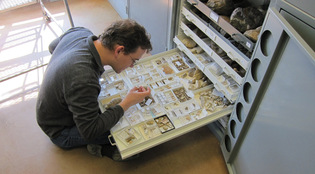 loading
loading
featuresCold case: dinosaur editionNick Longrich has found a half-dozen new species by looking at fossils other scientists had forgotten.  Margot Sanger-Katz ’02When Nick Longrich visits a museum collection, he wants to see everything. At the University of Wyoming this spring, he pored over every drawerful of Cretaceous material, hunting for new species. View full image
When Nick Longrich was a graduate student in paleontology, he knew he wanted to study the early evolution of birds, starting with the Archaeopteryx. For 150 years, the famous fossil had been considered the “first” bird. Every grade school student has seen a picture of the sprawling skeleton with its arched back and outstretched wings—almost perfectly preserved, right down to the feather impressions that first showed scientists that this animal, whose skeleton looked like a dinosaur’s, had probably taken flight. Longrich too had seen pictures, but he wanted to see the fossil itself. When he made his pilgrimage to the Humboldt University natural history museum in Berlin, he asked to see not just the well-known slab of stone that had been studied, photographed, and displayed all these years, but also the “counterslab”—the impression the bones had made in the mud 150 million years earlier, which had been sitting untouched in a safe. What he found completely changed his understanding of the animal. Along the bird’s hind legs, Longrich found distinct impressions of the type of long, asymmetrical feathers birds use for flight. It turned out that the people who had prepared the main slab all those years ago thought those feathers weren’t important and had chipped them off. Wondering why the animal would need flight feathers on its shins and thighs, Longrich studied aerodynamics. He bought textbooks on airplanes and modern bird flight. For his dissertation, he argued that the Archaeopteryx’s hind limb anatomy suggests it used both front and hind limbs for flight. It’s a proposal that could upend the consensus view about the evolution of bird flight. Longrich, 35, now a postdoctoral fellow at Yale with a long list of surprising and even flamboyant discoveries, is making his name by finding epiphanies among fossils that other scientists have already examined and put into storage. Instead of digging new creatures from the ground, he’s managed to solve several paleontological puzzles—and name a half-dozen new dinosaur species—by hunting for overlooked treasure among the scraps of fossil in old collections. He’s made significant new discoveries among decades-old specimens at Yale’s Peabody Museum, the American Museum of Natural History, the Smithsonian, the Museum of the Rockies in Montana, and others. Since coming to Yale in 2009, Longrich has published 18 papers in academic journals; only two were based on material he excavated from the field. “He collects in museum collections,” says Jacques Gauthier, the Yale professor who is supervising Longrich’s fellowship. Gauthier recommended Longrich for the position after seeing the then-graduate student identify a string of Yale’s fossils on sight during a short visit. “It’s kind of like prospecting in someone else’s digs.”
|
|